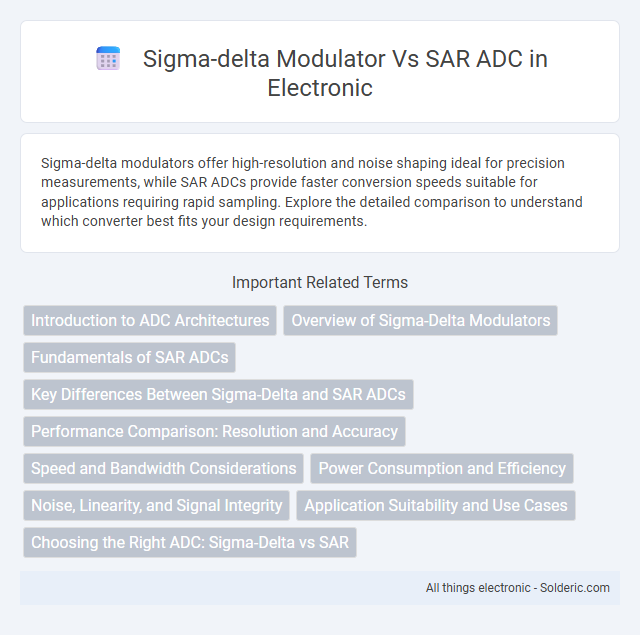Sigma-delta modulators offer high-resolution and noise shaping ideal for precision measurements, while SAR ADCs provide faster conversion speeds suitable for applications requiring rapid sampling. Explore the detailed comparison to understand which converter best fits your design requirements.
Comparison Table
| Feature | Sigma-Delta Modulator | SAR ADC (Successive Approximation Register) |
|---|---|---|
| Resolution | High (up to 24 bits) | Medium to High (typically 10 to 18 bits) |
| Speed / Sampling Rate | Low to Medium (up to a few MHz) | High (up to tens of MHz) |
| Power Consumption | Low to Moderate | Low (optimized for low power) |
| Input Bandwidth | Low to Moderate | Wide (up to Nyquist frequency) |
| Noise Performance | Excellent due to oversampling and noise shaping | Moderate, limited by comparator noise and DAC linearity |
| Complexity | High (digital filtering and decimation required) | Moderate (simpler architecture) |
| Typical Applications | Audio, Precision measurement, Sensor interfaces | Data acquisition, industrial control, high-speed sensing |
| Latency | Higher due to digital filtering | Low (near real-time) |
Introduction to ADC Architectures
Sigma-delta modulators leverage oversampling and noise shaping to achieve high-resolution analog-to-digital conversion, ideal for precise low-frequency signals and audio applications. SAR ADCs utilize a binary search algorithm to convert analog signals with fast conversion times and moderate resolution, making them suitable for medium-speed applications. Your choice between these architectures depends on the balance between resolution, speed, and power consumption required for your specific use case.
Overview of Sigma-Delta Modulators
Sigma-Delta modulators leverage oversampling and noise shaping to achieve high-resolution analog-to-digital conversion, making them ideal for applications requiring precise signal measurement such as audio and instrumentation. Unlike SAR ADCs, which perform successive approximation with moderate speed and resolution, Sigma-Delta ADCs provide finer resolution at the expense of slower conversion rates. Your choice between these converters depends on the balance of speed, resolution, and signal quality needed for your application.
Fundamentals of SAR ADCs
SAR ADCs (Successive Approximation Register Analog-to-Digital Converters) operate by iteratively comparing the input voltage to a generated reference voltage using a binary search algorithm. They utilize a sample-and-hold circuit followed by a digital-to-analog converter (DAC) and a comparator to successively approximate the input signal with each clock cycle, achieving conversion speeds typically suitable for medium-speed applications. SAR ADCs offer a balance between resolution and conversion rate, often found in applications requiring moderate to high accuracy with low power consumption, such as sensor interfaces and industrial control systems.
Key Differences Between Sigma-Delta and SAR ADCs
Sigma-Delta ADCs utilize oversampling and noise shaping to achieve high resolution and excellent dynamic range, making them ideal for audio and precision measurement applications. SAR ADCs offer faster conversion speeds and moderate resolution by employing a binary search algorithm, which suits applications requiring low latency and power efficiency. Your choice depends on balancing speed, resolution, and power consumption according to the specific requirements of your system.
Performance Comparison: Resolution and Accuracy
Sigma-delta modulators achieve higher resolution and accuracy by oversampling and noise shaping, making them ideal for applications requiring precise measurement of low-frequency signals. SAR ADCs offer faster conversion speeds but generally provide lower resolution compared to sigma-delta modulators, which limits their accuracy in detecting minute signal variations. Your choice depends on whether high resolution or fast conversion speed is more critical for your application.
Speed and Bandwidth Considerations
Sigma-delta modulators excel in high-resolution applications but are inherently limited by lower speed and bandwidth due to their oversampling nature and digital filtering requirements. In contrast, SAR ADCs offer faster conversion rates and wider bandwidth capabilities, making them suitable for moderate-resolution applications demanding rapid signal acquisition. Optimizing the trade-off between speed and resolution is critical when selecting between sigma-delta modulators and SAR ADCs for specific signal processing tasks.
Power Consumption and Efficiency
Sigma-delta modulators typically offer higher power consumption due to their oversampling and noise-shaping architecture, which demands continuous digital filtering and processing. SAR ADCs demonstrate superior power efficiency by employing a binary search algorithm that rapidly converges to the input signal value with minimal switching energy. In low-to-medium resolution applications, SAR ADCs are preferred for ultra-low power designs, while sigma-delta ADCs excel in high-resolution scenarios despite increased power overhead.
Noise, Linearity, and Signal Integrity
Sigma-delta modulators excel in noise shaping and high resolution, resulting in superior noise performance and excellent signal integrity for low-frequency applications. SAR ADCs offer better linearity and faster conversion speeds, making them ideal for high-speed, moderate-resolution tasks. Your choice depends on prioritizing noise tolerance and resolution (sigma-delta) or linearity and speed (SAR).
Application Suitability and Use Cases
Sigma-delta modulators excel in high-resolution, low-frequency applications such as audio processing and precision measurement, where oversampling and noise shaping enhance signal quality. SAR ADCs are preferred in medium to high-speed scenarios like data acquisition and industrial control due to their fast conversion times and moderate resolution. Your choice depends on balancing required resolution, speed, and power consumption for the specific application environment.
Choosing the Right ADC: Sigma-Delta vs SAR
Sigma-Delta modulators excel in high-resolution, low-frequency applications by using oversampling and noise shaping to achieve exceptional accuracy and signal-to-noise ratios, making them ideal for precision measurements in audio and instrumentation. SAR ADCs offer faster conversion speeds with moderate resolution, utilizing a binary search algorithm that efficiently balances power consumption and sample rate, ideal for battery-powered devices and real-time data acquisition. Choosing between Sigma-Delta and SAR ADCs depends on application requirements such as resolution, speed, power efficiency, and signal bandwidth to ensure optimal performance.
sigma-delta modulator vs SAR ADC Infographic

 solderic.com
solderic.com